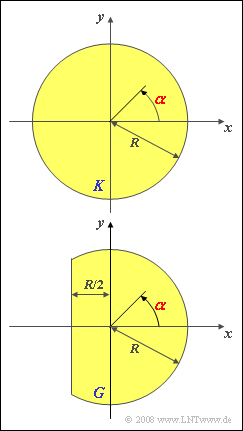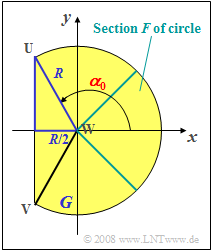Difference between revisions of "Aufgaben:Exercise 3.5Z: Antenna Areas"
m (Text replacement - "rms value" to "standard deviation") |
|||
| Line 41: | Line 41: | ||
| − | {What value results for the | + | {What value results for the standard deviation of the random variable $\alpha$ in the area $K$? |
|type="{}"} | |type="{}"} | ||
$\sigma_\alpha \ = \ $ { 1.814 3% } | $\sigma_\alpha \ = \ $ { 1.814 3% } | ||
Latest revision as of 12:11, 17 February 2022
We first consider – as sketched in the image above – a receiving antenna serving a circular area $K$. It is assumed that this antenna can detect all signals incident at different angles $\alpha$ equally well:
- According to the sketch, the angle $\alpha$ refers to the $x$–axis.
- The value $\alpha = 0$ therefore means that the signal is moving towards the antenna in the direction of the negative $x$–axis.
Further we assume:
- The range of values of the angle of incidence $\alpha$ with this definition $-\pi < \alpha \le +\pi$.
- There are very many users in the coverage area whose positions $(x, y)$ are "statistically distributed" over the area $K$.
From subtask (5) we assume the coverage area $G$ outlined below.
- Because of an obstacle, the $x$–coordinate of all participants must now be greaterö&space;than $-R/2$.
- Also in the coverage area $G$ the subscribers would again be "statistically distributed".
Hint:
- The exercise belongs to the chapter Uniformly Distributed Random Variables.
Questions
Solution
- $$f_\alpha(\alpha)={\rm 1}/({\rm 2\cdot \pi}).$$
- For $\alpha = 0$ this gives – as for all allowed values also – the PDF value :$$f_\alpha(\alpha =0) \hspace{0.15cm}\underline{=0.159}.$$
(2) It holds ${\rm E}\big[\alpha\big] = 0$ ⇒ Answer 1.
- It has no effect that $\alpha = +\pi$ is allowed, but $\alpha = -\pi$ is excluded.
(3) For the variance of the angle of incidence $\alpha$ holds:
- $$\sigma_{\alpha}^{\rm 2}=\int_{-\rm\pi}^{\rm\pi}\hspace{-0.1cm}\it\alpha^{\rm 2}\cdot \it f_{\alpha}(\alpha)\,\,{\rm d} \alpha=\frac{\rm 1}{\rm 2\cdot\it \pi}\cdot \frac{\alpha^{\rm 3}}{\rm 3}\Bigg|_{\rm -\pi}^{\rm\pi}=\frac{\rm 2\cdot\pi^{3}}{\rm 2\cdot\rm \pi\cdot \rm 3}=\frac{\rm \pi^2}{\rm 3} = \rm 3. 29. \hspace{0.5cm}\Rightarrow \hspace{0.5cm}\sigma_{\alpha}\hspace{0.15cm}\underline{=1.814}.$$
(4) Since the given section of the circle is exactly one quarter of the total circle area, the probability we are looking for is
- $${\rm Pr}(-π/4 ≤ α ≤ +π/4)\hspace{0.15cm}\underline{=25\%}.$$
(5) From simple geometrical ¨considerations (right-angled triangle, marked dark blue in the adjacent sketch) one obtains the equation of determination for the angle $\alpha_0$:
- $$\cos(\pi-\alpha_{\rm 0}) = \frac{R/ 2}{R}={\rm 1}/{\rm 2}\hspace{0.5cm}\Rightarrow\hspace{0.5cm}\rm\pi-\it\alpha_{\rm 0}=\frac{\rm\pi}{\rm 3} \hspace{0.2cm}\rm( 60^{\circ}).$$
- It follows $\alpha_0 = \pi/3\hspace{0.15cm}\underline{=2.094}.$
- This corresponds $\alpha_0 \hspace{0.15cm}\underline{=120^\circ}$.
(6) Correct is the suggested solution 3:
- The PDF $f_\alpha(\alpha)$ is f for a given angle $\alpha$ directly proportional to the distance $A$ between the antenna and the boundary line.
- For $\alpha = \pm 2\pi/3 = \pm 120^\circ$ against $A = R$, for $\alpha \pm \pi = \pm 180^\circ$ against $A = R/2$.
- In between the distance becomes successively smaller. This means: The PDF decreases towards the boundary.
- The decrease follows the following course:
- $$\it A=\frac{\it R/\rm 2}{\rm cos(\rm \pi-\it\alpha)}.$$
(7) The area $G$ can be calculated from the sum of the $240^\circ$–sector and the triangle formed by the vertices $\rm UVW$ :
- $$G=\frac{\rm 2}{\rm 3}\cdot \it R^{\rm 2}\cdot{\rm \pi} \ {\rm +} \ \frac{\it R}{\rm 2}\cdot \it R\cdot \rm sin(\rm 60^{\circ}) = \it R^{\rm 2}\cdot \rm\pi\cdot (\frac{\rm 2}{\rm 3}+\frac{\rm \sqrt{3}}{\rm 4\cdot\pi}).$$
- The probability we are looking for is given by the ratio of the areas $F$ and $G$ (see sketch):
- $$\rm Pr(\rm -\pi/4\le\it\alpha\le+\rm\pi/4)=\frac{\it F}{\it G}=\frac{1/4}{2/3+{\rm sin(60^{\circ})}/({\rm 2\pi})}=\frac{\rm 0.25}{\rm 0.805}\hspace{0.15cm}\underline{=\rm 31.1\%}.$$
- Although nothing has changed from point (4) at the area $F$ the probability now becomes larger by a factor $1/0.805 ≈ 1.242$ due to the smaller area $G$ .
(8) Since the overall PDF area is constantly equal $1$ and the PDF decreases at the boundaries, it must have a larger value in the range $|\alpha| < 2\pi/3$ than in (1).
- With the results from (1) and (7) holds:
- $$f_{\alpha}(\alpha = 0)=\frac{1/(2\pi)}{2/3+{\rm sin(\rm 60^{\circ})}/({\rm 2\pi})} = \frac{\rm 1}{{\rm 4\cdot\pi}/{\rm 3}+\rm sin(60^{\circ})}\hspace{0.15cm}\underline{\approx \rm 0.198}.$$
- Like the probability in (7) also simultaneously the PDF value in the range $|\alpha| < 2\pi/3$ increases by a factor $1.242$ as the coverage area becomes smaller.

